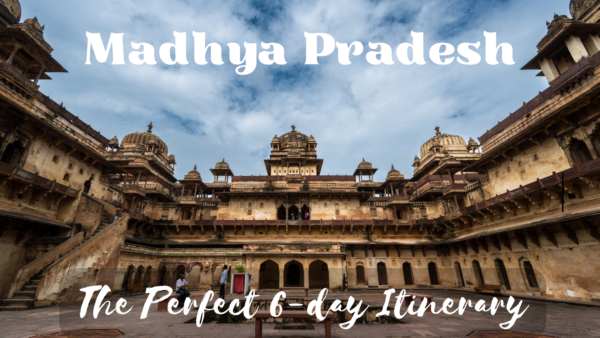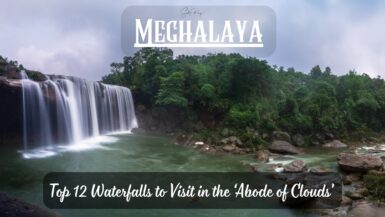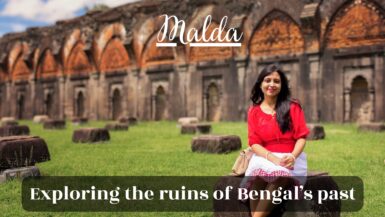Madhya Pradesh is one of the most incredible states in India. The entire landscape of this central Indian state is teeming with historical ruins, some of which even date to pre-historic times. Here lies Bhimbetka Caves with paintings of pre-historic humans, the Buddhist Stupa at Sanchi, the architectural marvels of Mandu, the temples of Khajuraho, and so much more. It is also a treasure trove for nature and wildlife enthusiasts thanks to its National Parks and Wildlife Sanctuaries at Bandhavgarh, Kanha, Pench, Panna, and so on. Moreover, it has a number of religious hotspots such as Ujjain, Omkareshwar, Mahakaleshwar, and Amarkantak. All in all, if you are a traveller, Madhya Pradesh should certainly feature on your bucket list.

However, being the second largest state of India, it is quite impossible to cover the entire Madhya Pradesh in one go. Generally, Madhya Pradesh has four broad sections – the western part consisting of Indore, Mandu, Ujjain, Omkareshwar, and Bhopal; the eastern part comprising Khajuraho, Panna, Orchha, and Chitrakoot; the northern part encompassing Gwalior, Shivpuri, and Chanderi; the southern part covering Jabalpur, Amarkantak, Bandhavgarh, Pench, and Kanha.
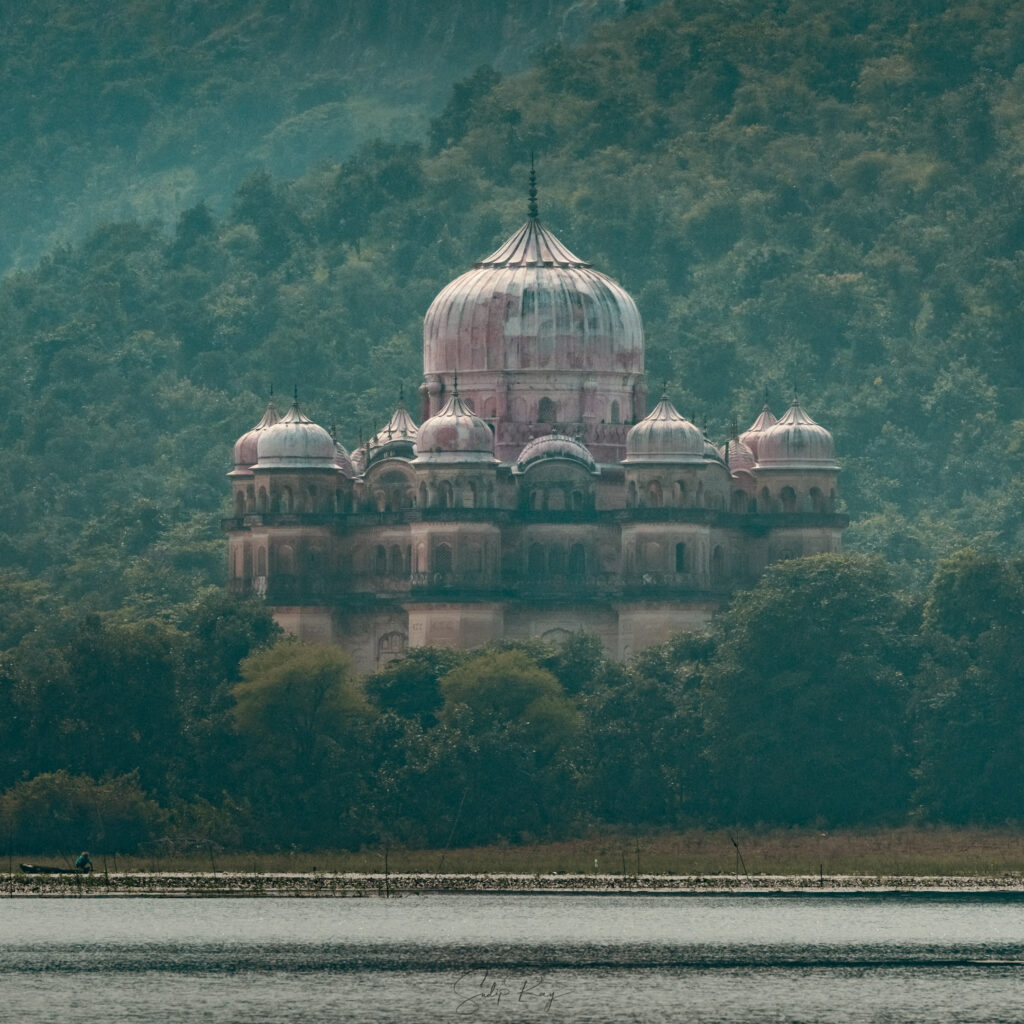
For this trip, we concentrated on the eastern and northern parts of Madhya Pradesh. We basically wanted to explore the archaeological sites and historical ruins found in these areas. It took us 6 full days to cover these parts. Here goes our 6-days itinerary for exploring Madhya Pradesh.

Table of Contents
Day 1: Reaching Khajuraho and exploring the temples
A pleasant autumn morning welcomed us as we alighted from the train in Khajuraho. The Gita Jayanti Express, which we boarded from New Delhi the previous evening, reached Khajuraho 30 minutes before its scheduled time. Outside the station, it was bustling with passengers, who haggled with a handful of auto-rickshaws and shared trekkers.
We took an auto to cover the 6 km ride to the temple town of Khajuraho. As we drove through the bumpy road, Khajuraho reminded us of Hampi. Like Hampi, we could inhale the whiff of history even before we entered the main town of Khajuraho.
We checked in at Hotel Harmony, which is just a stone’s throw away from the Western Group of Temples. Earlier, we had decided to take a rest and a quick nap before exploring Khajuraho as we were dead tired after a helluva journey (that consisted of two overnight train journeys and air travel). However, once we had set our feet in Khajuraho, all our exhaustion vanished into thin air. We swiftly showered, got dressed, devoured dosas and pooris, and set out on our adventure.
A bit of Khajuraho’s history will be handy here. Khajuraho was the religious capital of the mighty Chandelas, who went on an extraordinary spree of constructing temples, seen never before or afterwards in the entire Indian subcontinent. The Chandelas built as many as 85 temples in Khajuraho, an unmatched feat that has immortalized the name of the Chandelas in the annals of Indian history. The temples in Khajuraho testify to the exceptional engineering skill of the Chandela architects. All in all, the Khajuraho temples manifest the zenith of India’s Nagara style of architecture. However, Khajuraho went into oblivion from the 11th century and its history was revived by the eminent archaeologist Alexander Cunningham in the 19th century.
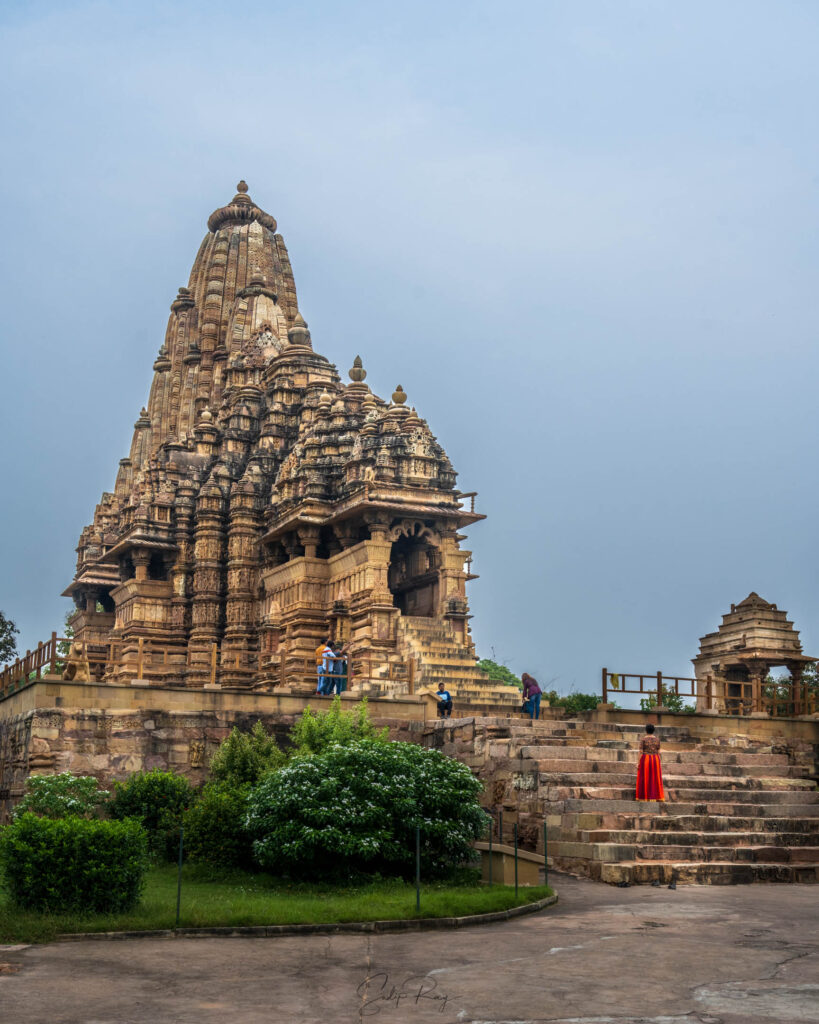
The massive temples are living specimens of the excellent skill of Chandela architects and sculptors and prove their mastery. The mere mention of Khajuraho evokes images of erotic sculptures of couples engaged in copulation. In fact, Khajuraho has become synonymous with erotic temple sculptures, which depict various forms of ‘mithuna’. Funnily enough, only 10% of Khajuraho’s temple carvings are erotic in nature. The enormous volume of carvings on the walls of Khajuraho temples belongs to Hindu deities, Dikpalas, demi-gods like Ganas and Gandharvas, Celestial Women such as Apsaras and Surasunadaris, amorous couples, animals, secular scenes like war and hunting, and geometric and floral designs.
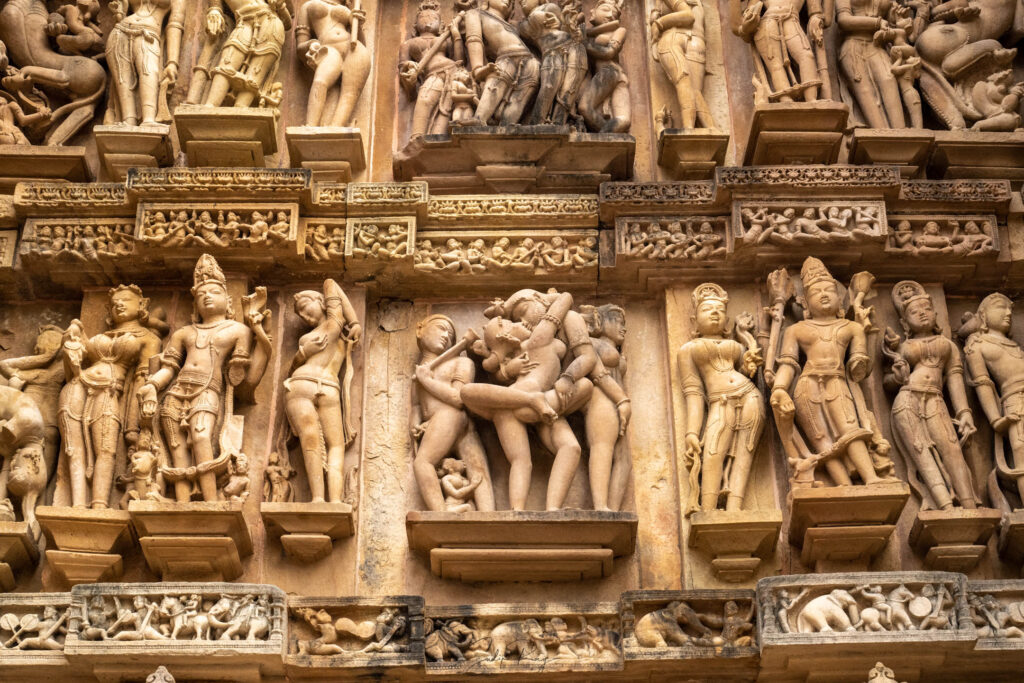
The temples in Khajuraho are spread across a vast area. Hence, they are categorized into three sections: Western Group, Eastern Group, and Southern Group.
We started exploring Khajuraho with the Western Group of Temples. The temples in this area are the most well-preserved and perhaps the most beautiful ones in Khajuraho.

One by one, we visited the Lakshmana Temple (dedicated to Vaikuntha Vishnu), Devi Shrine (a statue of Brahmani sits inside), Varaha Mandapa, Kandariya Mahadeva Temple (devoted to Lord Shiva), Mahadeva Shrine, Devi Jagadambi Temple (houses an idol of Devi Parvati), Chitragupta Temple (consecrated to Surya, the Sun God), Vishwanatha Temple (dedicated to Lord Shiva), and Chausath Yogini Temple.
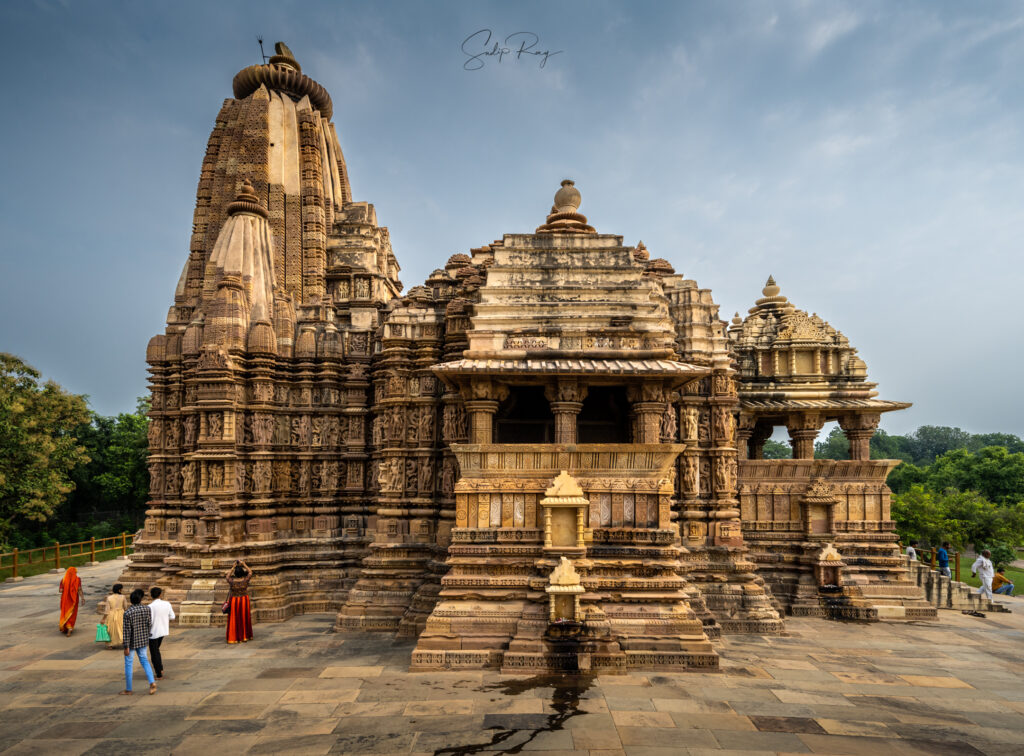
Exploring the Western Group of Temples took the entire morning. It was time for lunch when we finished. Following lunch, we visited the new ASI museum near Hotel Lalit. The museum is vast and has well-stacked galleries.
Next, we went to the two temples of Southern Group. These temples are situated a bit away from the main town. Both the Duladeva Temple (dedicated to Lord Shiva) and Chaturbhuja Temple (accommodating an admirable Vishnu statue in ‘tribhanga’ position) were extraordinarily beautiful.
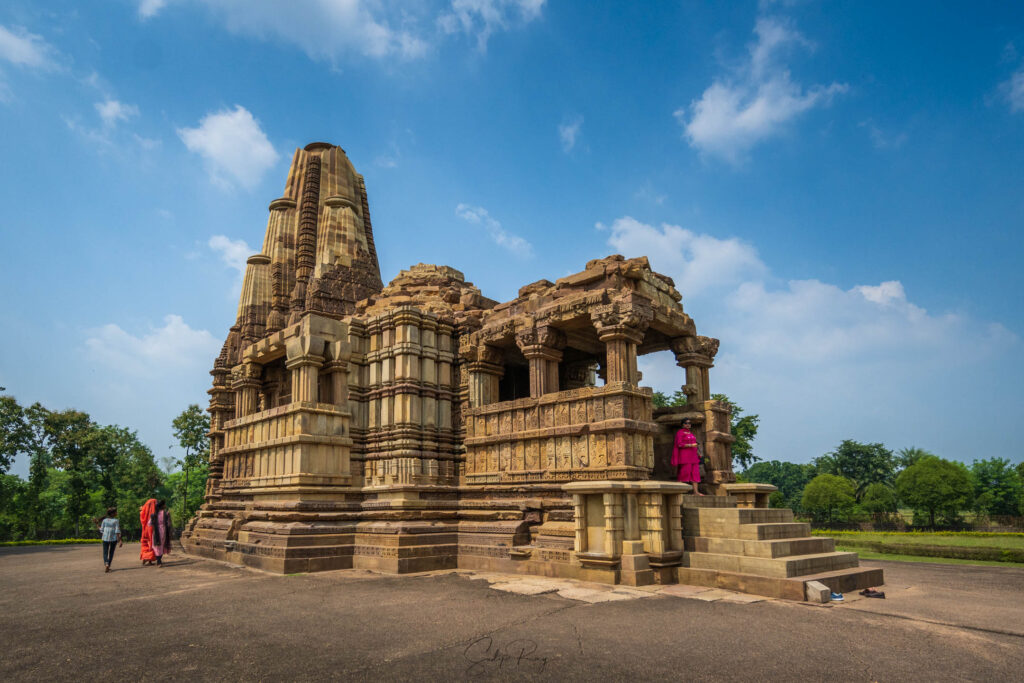

Day 2: Visiting Eastern Group of Temples and Raneh Waterfalls:
We started our second day with a lip-smacking breakfast at Raja Café. Later, we visited the Eastern Group of Temples. This cluster of temples is located around the Khajura Sagar, also known as the Ninora Tal. The main temples of this group are Vamana Temple (dedicated to Vishnu’s 5th incarnation), Javari Temple (devoted to a four-armed Vishnu), Brahma Temple (houses a Shiva linga with four faces), and Ghantai Temple (ruins of a Jain temple).



Afterwards, we explored the Jain temples of Khajuraho such as the Parshvanatha Temple, Adinatha Temple, and Shantinatha Temple. With this, we finished our temple trail in Khajuraho.
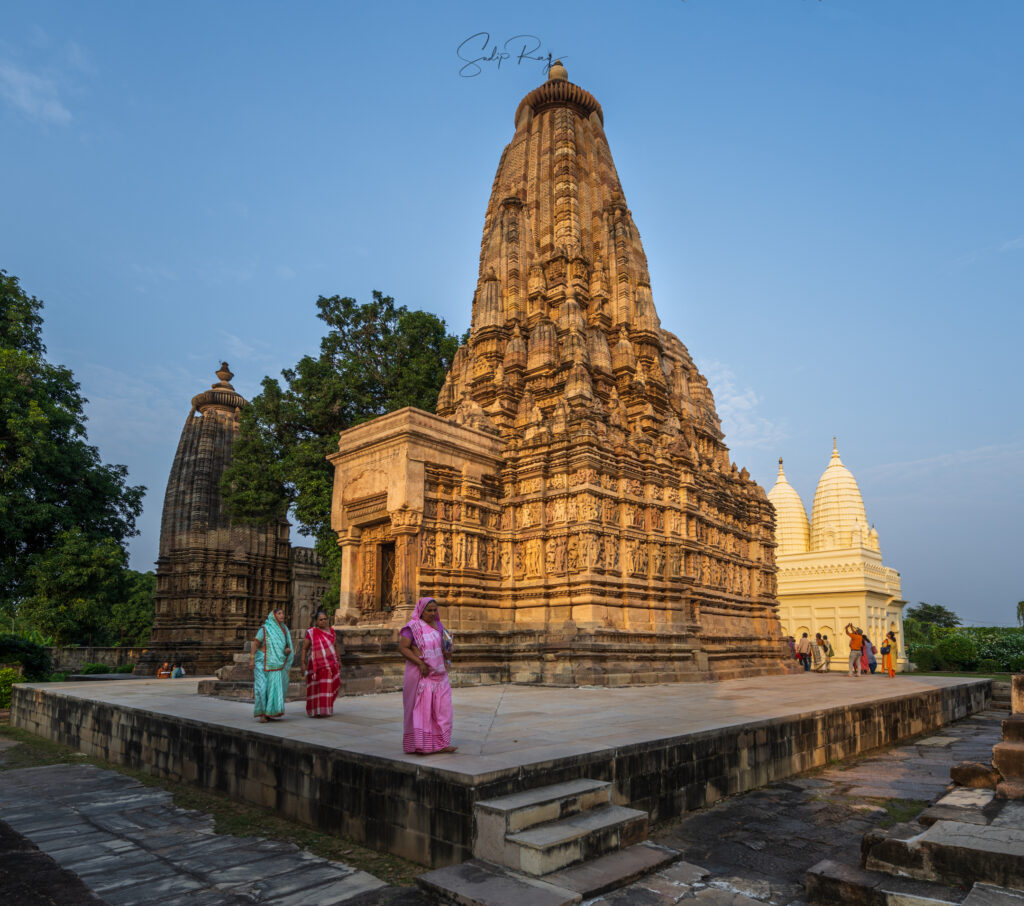
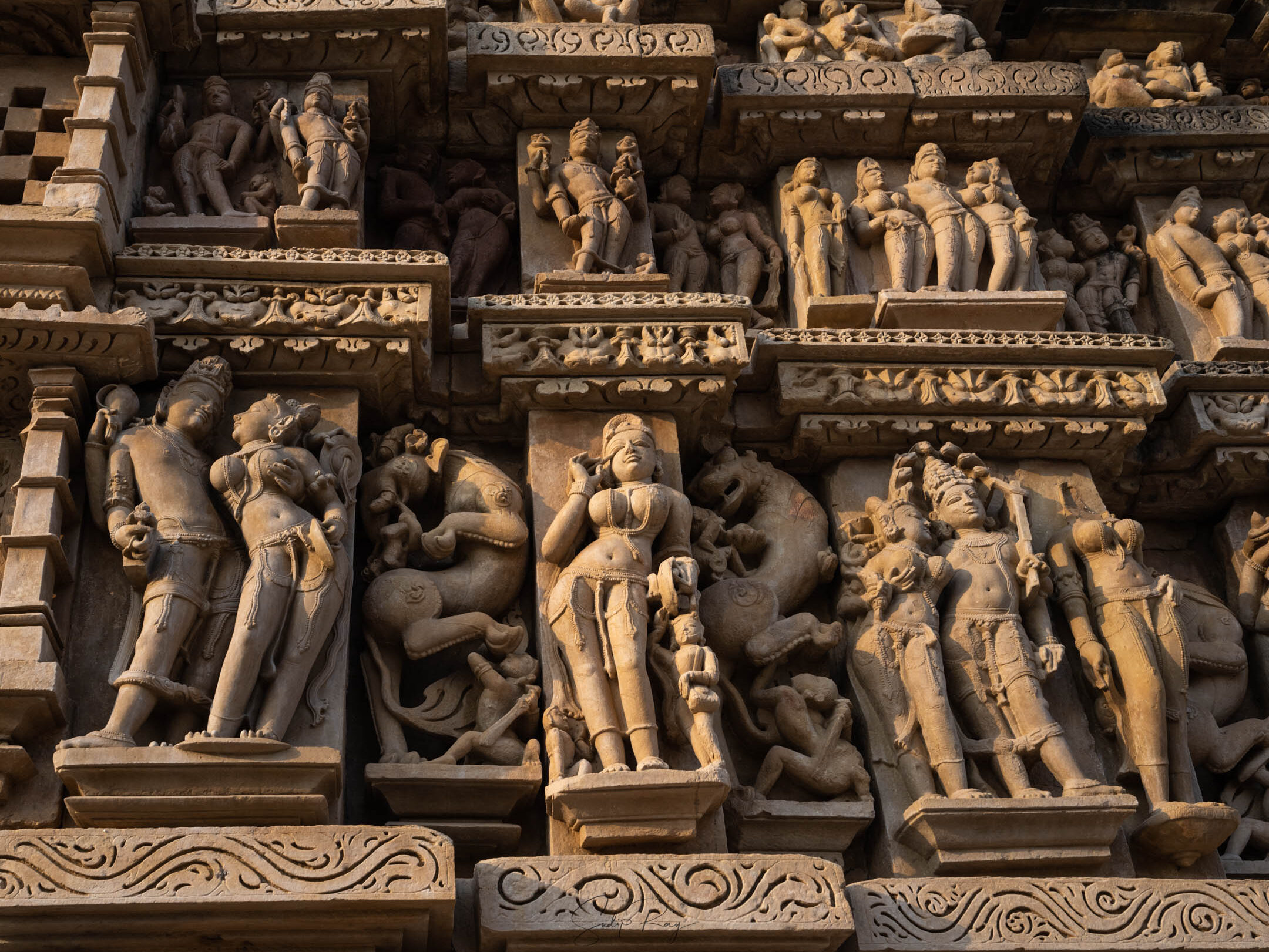
Post-lunch, we decided to visit the Raneh Waterfalls. It lies some 20 km away from Khajuraho and can be reached within 30 minutes.
Raneh is a natural waterfall on the Ken River. The river’s erosional activity has led to the formation of 98 feet deep canyon made up of granite in varying shades of colours ranging from pink and red to black and grey.

We finished exploring Khajuraho with the Light and Sound Program held at the Western Group.
Day 3: A quick stop at Dhubela on the way to Orchha:
On our third day, we bade Khajuraho adieu and headed towards Orchha. En route, we halted at Dhubela. At present, Dhubela is an otherwise run-of-the-mill village, characterized by lush greenery. But, in the past, it served as the centre of Maharaja Chhatrasal’s Bundelkhand kingdom. Dhubela has also become synonymous with Chhatrasal’s legendary daughter, Mastani. Mastani, who was later married to Peshwa Baji Rao I, spent a good part of her life in Dhubela and so, Dhubela is often referred to as the land of Mastani.
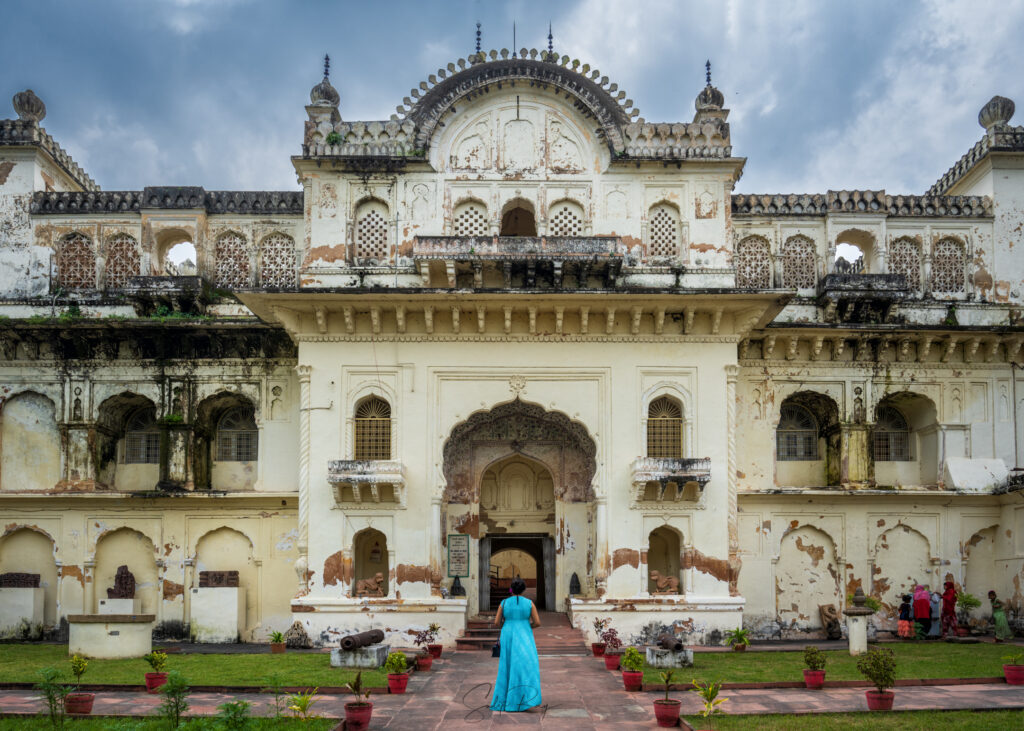
Dhubela still bears the testimony of a once-prosperous kingdom. The village is dotted with various architectural specimens built by Chhatrasal, who is famously called the ‘Lion of Bundelkhand’. We visited the following places in Dhubela:
1. Maharaja Chhatrasal Museum– it once served as the palace of Chhatrasal and is now converted into a fascinating museum showcasing Gupta and post-Gupta era artefacts excavated from various parts of Bundelkhand.
2. Mastani Mahal-a palace built by Chhatrasal for his beloved daughter Mastani.

3. Hriday Shah Palace– a dilapidated palace built by Chhatrasal’s eldest son, Hriday Shah.
4. Chhatri of Maharani Kamlapati– the cenotaph of Chhatrasal’s first wife Kamlapati which stands on the bank of the Dhubela Lake and is decorated with around 140 Bundeli-style of paintings.
5. Chhatri of Maharaja Chhatrasal– the cenotaph of the valiant ruler built by Peshwa Baji Rao I.
6. Chhatri of Chhatrasal’s Horse– the cenotaph of Chhatrasal’s faithful horse, Bhale Bhai.
7. Sheetal Garhi– a 17th-century fortress built by Keerat Singh, the grandson of Chhatrasal.
8. Mahoba Gate– a spectacular gate built by Chhatrasal.
After our brief yet memorable sojourn in Dhubela, we drove straight ahead and reached Orchha in the afternoon.
We quickly checked in the hotel and head out to catch the sunset at Betwa River with the Chhatris on the backdrop. Alas! No sooner had we reached the riverside than the rain started. Our plan of enjoying the sunset sadly went down the drain.
Day 4: Exploring the erstwhile Bundeli capital of Orchha:
The next morning, thankfully the weather turned sunny and perfect for exploring the historic town of Orchha. Before embarking on the journey, let’s learn one or two bits about Orchha’s history. Orchha was made the capital of the Bundeli kingdom by Raja Rudra Pratap Singh in 1531 CE. It remained the capital of the entire Bundelkhand from 1531 to 1783 CE. Rugged hills, dense forest and the Betwa or Vetravati River surrounded Orchha thus securing it and hiding it from the onslaught of the Mughal forces. In fact, the word ‘Orchha’ aptly means hidden. The town remained hidden from the Mughals and continues to remain elusive to tourists and explorers even today.
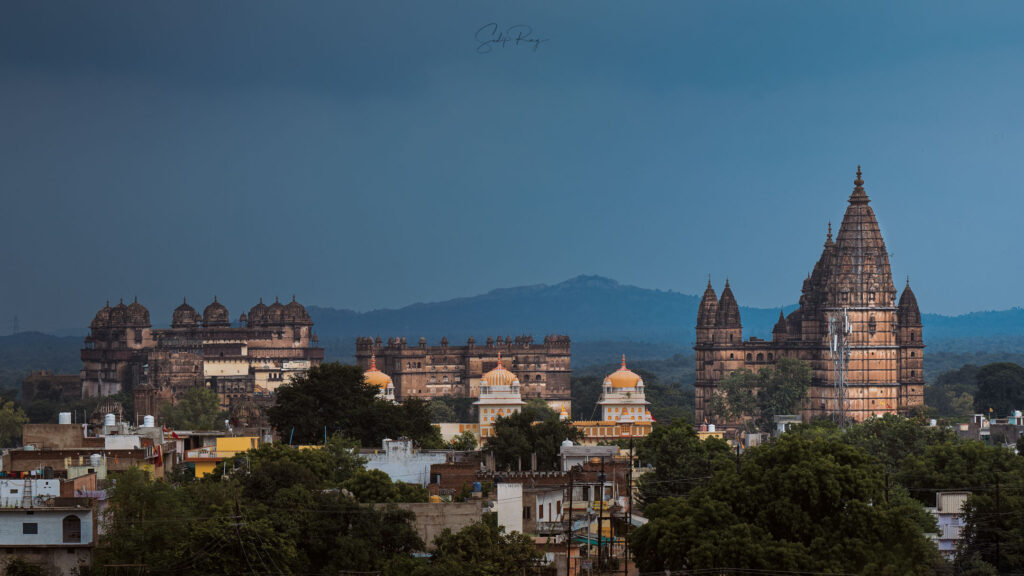
We kicked off our adventure in Orchha with its eponymous fort. The imposing Orchha Fort is an amalgamation of massive and magnificently built palaces. It took us over 4 hours to explore the entire Orchha Fort complex. Also, we opted for the audio tour guide of Madhya Pradesh tourism. It was cheap (INR 25 per pre-recorded audio guide along with headphones), incredibly informative and convenient, and also gave us the freedom to explore the sites as per our choice.
Gradually, we took a tour of various sections of the Fort:
1. Diwani-e-Aam– a court where the King used to hold assemblies with his council of ministers.
2. Raja Mahal– it was built by Raja Madhukar Shah and characterized by a fusion of Mughal and Rajput styles of architecture as well as lavish Bundeli style of paintings.

3. Jahangir Mahal– it was constructed by Raja Bir Singh Deo Bundela for Mughal Emperor Jahangir and set apart by 8 domes and 236 chambers, intricately carved doors with elaborate arches and interiors decorated with trellis work, lapis lazuli inlays, and glazed blue tiles.

4. Sheesh Mahal– it was built as a pleasure retreat and is now converted into a heritage hotel by Madhya Pradesh Tourism.

5. Rai Parveen Mahal– it was the home of the beautiful courtesan, Rai Parveen.
After travelling the nooks and crannies of the Orchha Fort for 4 hours, we took a quick rest and a brief lunch at the restaurant of the Sheesh Mahal. Recharging ourselves, we set out to explore the rest of Orchha.
Our next destination was the iconic Chhatris of Orchha. The Chhatris are cenotaphs of Bundela rulers of Orchha, earmarking the ground where the Kings were cremated.
There are 14 Chhatris, built between the 16th and 18th centuries. Apart from Bir Singh Deo’s Chhatri which resembles a palace, the cenotaphs follow the Nagara style of temple architecture. They are modelled on ‘panchayatana’ style with ‘garbhagriha’ inside and ‘shikharas’ at the top.
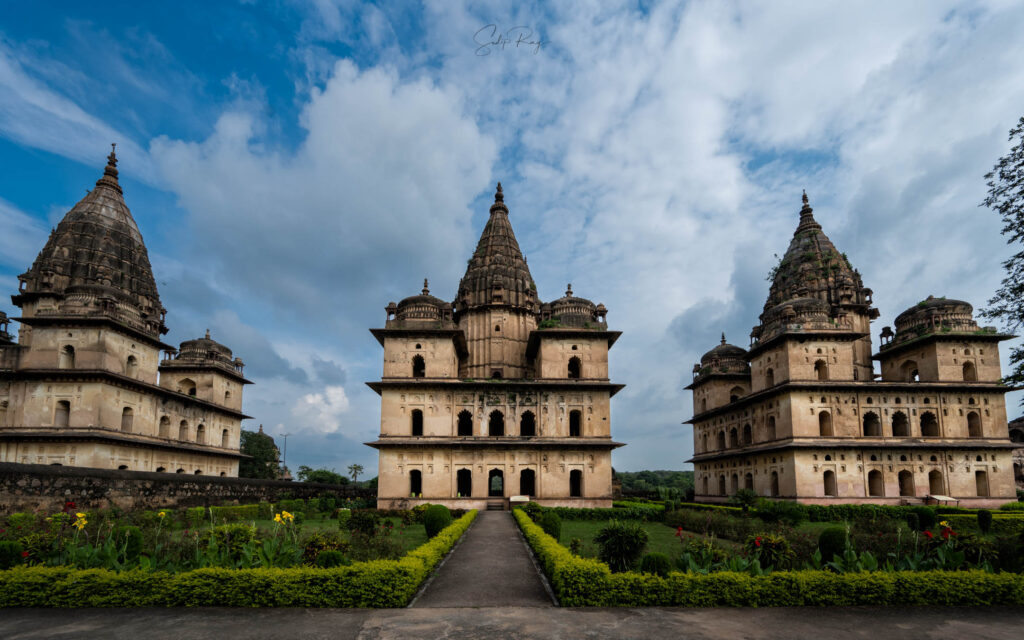
Next, we climbed a small hillock to reach the breathtaking Laxmi Narayan Temple. It was built by Raja Bir Singh Deo Bundela. The temple is a unique structure as it resulted from the mingling of architectural styles of both temple and fort.

The most intriguing feature of this temple is the presence of vivid murals on its interior walls and ceilings. The lively, colourful paintings are the finest specimens of Bundeli style of painting, which resulted from a marriage of Rajput and Mughal styles.

Afterwards, we reached the sky-kissing Chaturbhuj Temple. It was here that the idol of Ram Chandra was originally supposed to be placed. The 105-metre-high temple now houses a statue of Shree Krishna and Shree Radhika, worshipped daily at regular intervals.
The exterior of this massive temple is ornately decorated with floral motifs and religious emblems. In stark contrast, the interior is plain and austere.
Our last stop at Orchha was the Ram Raja Temple. It is the only temple in India where Ram Chandra is worshipped as King. The evening arati at Ram Raja Temple is a spectacle to behold.

After finishing the tour of Orchha, we drove to Jhansi. From Jhansi, we boarded the train and reached Gwalior in the evening.
Day 5: Waking up in a cloudy Gwalior and exploring Morena:
We woke up to peacocks’ call on our fifth morning. We were staying at Neemrana’s Deobagh in Gwalior, and the peacocks’ divine call served as our alarm clocks. Instead of rushing out to explore Gwalior, we took it slow and enjoyed a relaxing morning on the well-curated lawn of Deobagh with the peacocks and squirrels as our companions.
After a comforting breakfast, we decided to explore the archaeological ruins of the three sites in Morena – Bateshwar, Garhi Padavali, and Mitaoli. With a cloudy sky and a light drizzle, we set out for Morena.
Our first stop for the day was the intriguing Bateshwar Group of Temples. The temple complex, situated amidst the once infamous Chambal ravines, was previously a jumble of countless ruined structures. Gradually, the Archaeological Survey of India (ASI) went to unprecedented lengths and restored many of the shrines here. At present, Bateshwar has around 200 temples. In fact, ASI is still engaged in restoration works in Bateshwar.

The name Bateshwar is probably derived from Bhooteshwar, another name of Lord Shiva. According to experts, the Bateshwar Group of Temples belongs to the Gurjara – Pratihara era. The shrines of Bateshwar were built between 750 – 800 CE. Eventually, the temples were reduced to mere rubbles. It is however unclear as to how these shrines were destroyed. No sign of invasion or attack was found here. Presently, the common consensus is that an earthquake in the 13th century led to the decay of Bateshwar. Gradually, the debris was engulfed by the forest and Bateshwar remained hidden from the prying eyes.

As we walked, the riveting archaeological site began to unfold before us. Present-day Bateshwar can best be described as rows of small temples arranged in neat order amidst the scattered ruins. The entire site is filled with broken pillars, wrecked friezes, and fragmented sculptures. A Hanuman statue, smeared with orange vermillion, stands at the centre and is still worshipped by the locals. Needless to say, we were overwhelmed by the plenitude of artefacts in Bateshwar.
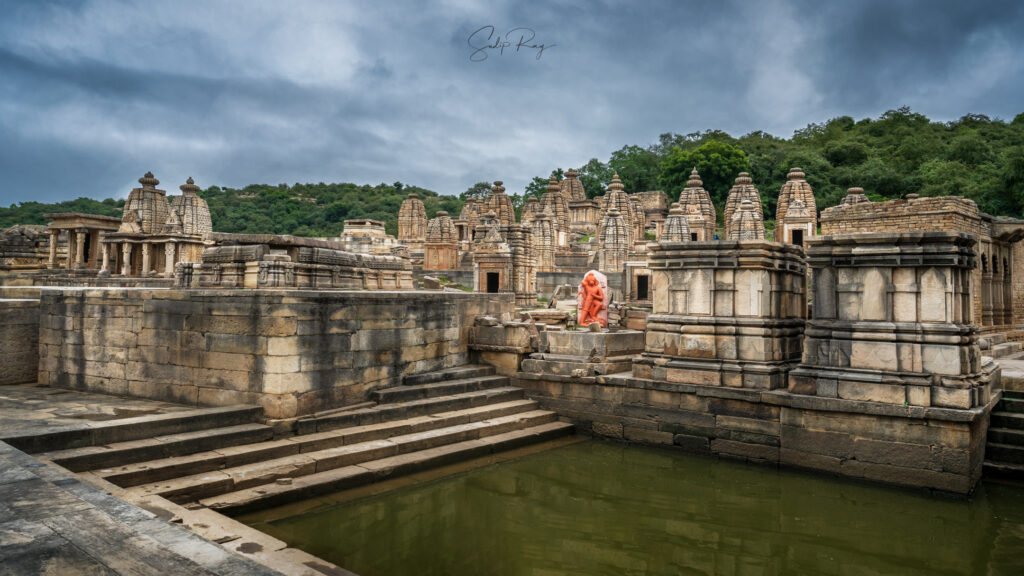
After Bateshwar, we visited the Garhi Padavali where stands an insanely carved ‘mukha mandapa’ of a temple, the main portion of which is now lost in oblivion. It is undoubtedly one of the most intricately carved temples in India. There is hardly an inch left without elaborate sculptures. Every pillar and ceiling is decorated with ornate carvings.

We were stunned by the exquisite wall panels showcasing the Trimurti, the birth of Shri Krishna, Goddess Chamunda, the Sun God Surya, and the slaying of Abhimanyu in the battle of Kurukshetra.

Our last stop in Morena was the Chausath Yogini Temple of Mitaoli. At present, it goes by the name of Ekattarso Mahadeva Temple. The temple is circular and roofless, as tantric rituals involved worshipping the environment along with its five principal elements, also due to the belief that the yoginis could fly. Due to its hypaethral structure, it is also believed that this temple was built for the study of astrology, astronomy, and mathematics by observing the transition of the sun.
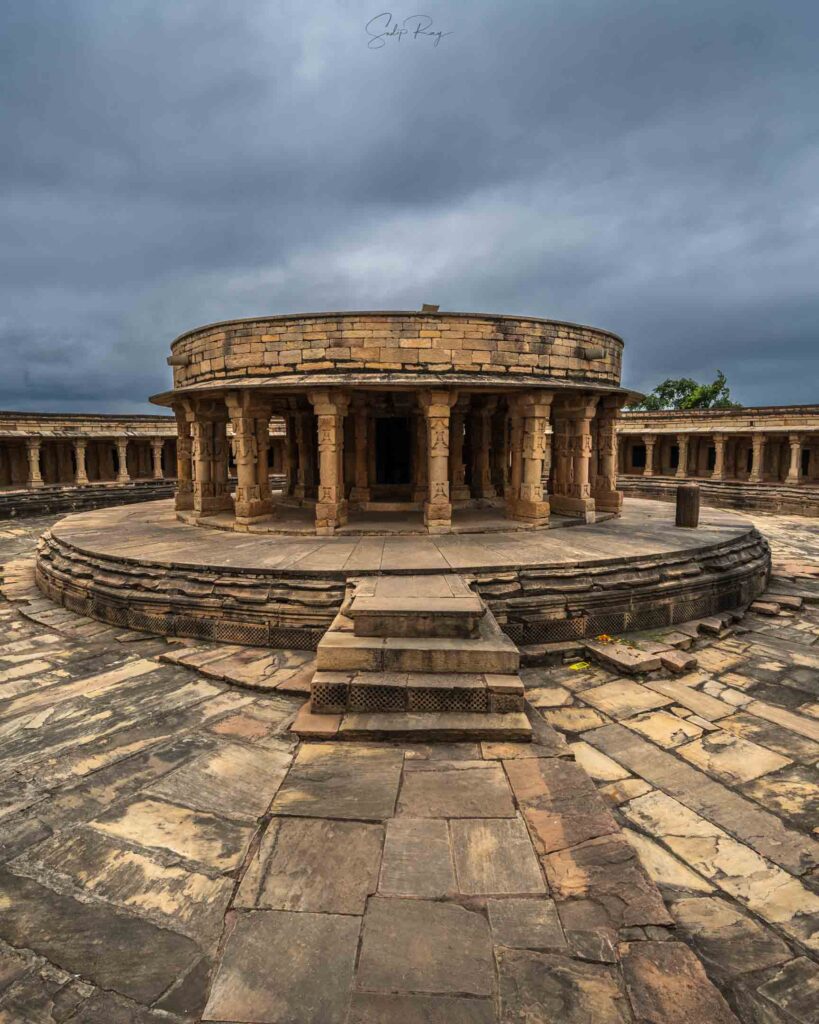
The temple is circular, with a radius of around 52 m. The outer round-shaped wall has 64 small chambers with an open ‘mandapa’ supported by pilasters and pillars. These chambers once accommodated the representation of the ‘yoginis’. At present, they contain small Shiva lingas. At the centre, there stands another circular temple, which houses the Ekattarso Mahadeva linga.

As we strolled around the temple and peeked inside the minuscule chambers, we sensed the strong presence of a spiritual aura. This may be due to the fact that this Chausath Yogini temple was one of the foremost places in ancient India for practising Tantric rituals.
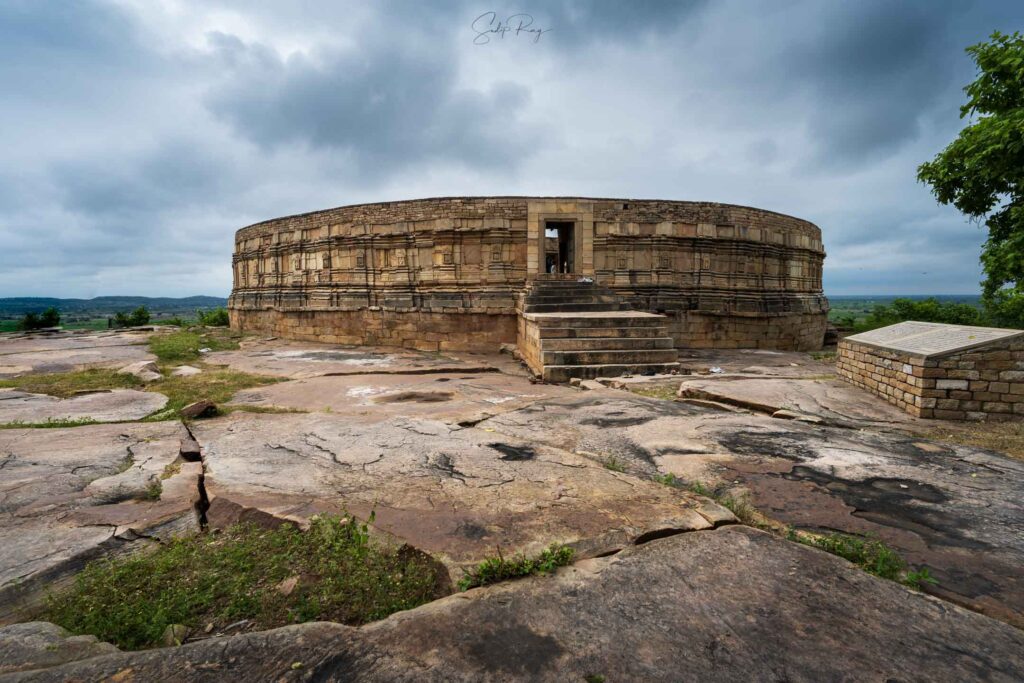
After exploring Morena, we decided to go on a food trail in the streets of Gwalior. We relished the renowned Boondi Laddoo of Bahadura Sweets, Gajaak from the well-known Daulat Ram Gajaak Bhandar, Paneer Jalebi and Kachori at Jodhpur Mishtaan Bhandar, and Gilori Petha at the iconic Panchiraaj.
Day 6: A date with the eponymous Fort of Gwalior:
On our last day in Madhya Pradesh, we visited the resplendent Gwalior Fort. The Fort, set atop a solitary rocky outcrop of the Vindhyas and spread across a staggering 3 square kilometres and rising 36 feet, is a wonder in itself.

The fort is comprised of various monuments that date back as early as the 7th century CE. It took us almost 5 hours to complete exploring this enormous Fort.
1. Sculptures of Jain Tirthankaras– the rock-cut sculptures found in the Gopachal and Siddhanchal Hills.
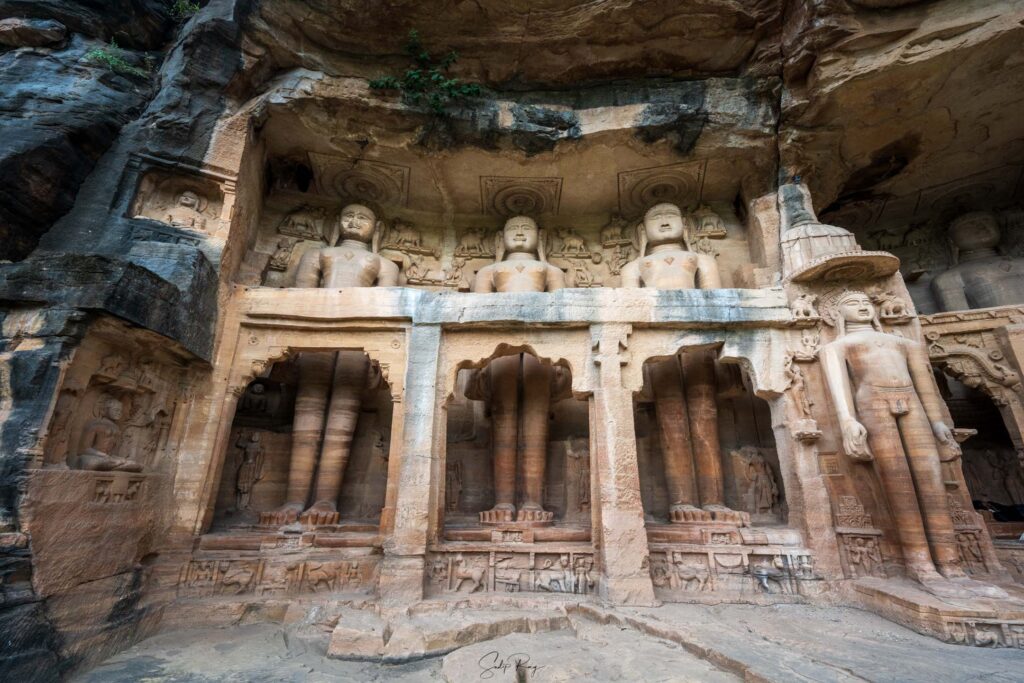
2. Man Singh Palace– the grandest and most stunning section of the Gwalior Fort characterized by six colossal cylindrical towers capped with cupolas, corbelled brackets, elaborate lattice-work, chhattris, and vibrant mosaic tiles.

3. ASI Museum– it is situated inside a building which dates back to the British era.
4. Kirti Mandi– the handiwork of Raja Kirti Singh Tomar with faint traces of painting and coloured tiles.
5. Vikramaditya Palace– it was built in 1516 CE and named after Raja Vikramaditya, son of Raja Man Singh.
6. Jahangir Mahal & Shahjahan Mahal– it was used as a resting place for Mughal troops rather than for royalty.
7. Teli Ka Mandir, one of the loftiest buildings within the premises of the Gwalior Fort and set apart by its hybrid architecture of Dravida and Nagara styles.

8. Saas-Bahu Temple– these twin temples were built by the Kacchapaghata ruler, Mahipala, in 1093 CE and originally called Sahasra Bahu Temple as it was dedicated to a thousand-armed form of Lord Vishnu.

9. Chaturbhuj Temple– it houses an inscription that contains one of the earliest known uses of mathematical zero.
10. Gurudwara Data Bandi Chhor– it was constructed to commemorate Guru Hargobind Singh’s incarceration inside the Gwalior Fort by Mughal Emperor Jahangir.
11. Gurjari Mahal– a charming palace built by Raja Man Singh for his Gujjar queen, Mariganayani.
Post-lunch, we went to the Jai Vilas Palace. This opulent palace is the residence of the Scindias, the erstwhile rulers of Gwalior. Originally, this lavish palace was constructed to welcome the then Prince of Wales. It was designed by Lt. Col. Sir Michael Filose and displays a fusion of both Tuscan and Corinthian architectural styles. Although it is still used by the Scindias as their residence, a part of it with 35 rooms has been converted into Jiyaji Rao Scindia Museum.

During sunset, we paid a visit to the tomb of Muhammad Ghaus, who was a 16th-century Sufi saint and also a prolific music master. Mian Tansen was one of his foremost disciples.
Mohammad Ghaus’s tomb was commissioned by Mughal Emperor Akbar and depicts a synthesis of the Lodhi style of architecture and structural ornamentation peculiar to Gujarat. The mausoleum is a marvellous specimen of delicate craftsmanship. Built with sandstone, it is decorated with lattice or ‘jali’ works on all sides.

In the same compound lies the final resting place of Sangeet Samrat Tansen. Compared to his master’s resting place, Tansen’s tomb is modest.
With Tansen’s Tomb, our Gwalior tour came to an end.
Some important FAQs:
How can I reach Madhya Pradesh:
- By air: Both Khajuraho and Gwalior have airports. Although Gwalior is well-connected with the rest of India, the same cannot be said about Khajuraho. Further, the airport in Khajuraho often remains out of service.
- By train: You can reach Khajuraho by train from New Delhi through 11842 Gita Jayanti Express. To reach Gwalior, you can board 20172 Vande Bharat Express, 12002 Shatabdi Express, and 12050 Gatimaan Express; from Howrah through 12175 Chambal Express; from Chennai through 12621 Tamil Nadu Express and 12615 Grand Trunk Express; from Mumbai through 12617 Mangladweep Express, 22221 Rajdhani Express, and 12137 Punjab Mail.

Where can I stay in Madhya Pradesh:
- In Khajuraho: Hotel Harmony, Hotel Isabel Palace, Hotel Khajuraho Inn, Ramada by Wyndham, and Lalit Temple View.
- In Orchha: Amar Mahal, MPT Sheesh Mahal, MPT Betwa Retreat, and Hotel Orchha Palace.
- In Gwalior: Neemrana’s Deobagh, Hotel Landmark, and Clarks Inn Suites.
Where to eat in Madhya Pradesh:
- In Kahjuraho: Badri Seth Marwari Bhoj and Raja Café.
- In Orchha: Sheesh Mahal, Café Nomads, and Open Sky Restaurant.
- In Gwalior: SS Kachoriwala, Bahadura Sweets, Jodhpur Mishtaan Bhandar, and Agarwal Poga Bhandar.
